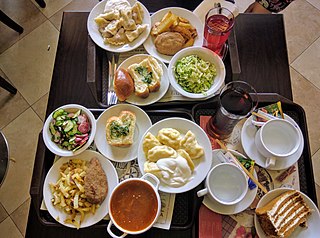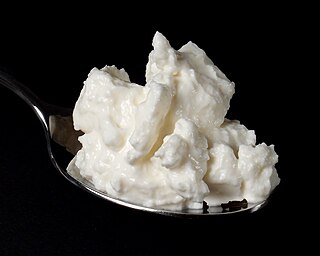
Syrniki or syrnyky are fried Eastern Slavic quark pancakes. They are a part of Belarusian, Russian, Estonian, Ukrainian, Latvian, Lithuanian (varškėčiai) and Serbian cuisine. In Russia, they are also known as tvorozhniki (творо́жники).

Russian cuisine is a collection of the different dishes and cooking traditions of the Russian people as well as a list of culinary products popular in Russia, with most names being known since pre-Soviet times, coming from all kinds of social circles.

Kissel or kisel is a simple dish with the consistency of a thick gel. It belongs to the group of cold-solidified desserts, although it can be served warm.

Ukrainian cuisine is the collection of the various cooking traditions of the people of Ukraine, one of the largest and most populous European countries. It is heavily influenced by the rich dark soil from which its ingredients come, and often involves many components. Traditional Ukrainian dishes often experience a complex heating process – "at first they are fried or boiled, and then stewed or baked. This is the most distinctive feature of Ukrainian cuisine".

A mille-feuille, also known by the names Napoleon in North America, vanilla slice in the United Kingdom, and custard slice, is a French dessert made of puff pastry layered with pastry cream. Its modern form was influenced by improvements made by Marie-Antoine Carême.

Smetana is the English-language name for the types of sour cream traditionally prevalent in Central, Eastern, and Southeastern Europe. It is a dairy product produced by souring heavy cream. It is similar to crème fraîche, but nowadays mainly sold with 9% to 42% milkfat content depending on the country. Its cooking properties are different from crème fraîche and the lighter sour creams sold in the US, which contain 12 to 16% butterfat. It is widely used in cooking and baking.

Ptasie mleczko or Bird's milk is a Central European confectionery originating in Poland. It is a small, chocolate-covered bar with a soft marshmallow-like interior.
Chak-chak is a popular fried dough food in Tatarstan and Bashkortostan.

Pirog is a baked case of dough with either sweet or savory filling. The dish is common in Eastern European cuisines.

Tula pryanik is a famous type of imprinted Russian pryanik from the city of Tula. Usually, Tula pryanik looks like a rectangular tile or a flat figure. Making stamped pryanik is considered an art form. The imprints could include different patterns, symbols, images of the Tula Kremlin, names, congratulations.

Zefír is a type of soft confectionery made by whipping fruit and berry purée with sugar and egg whites with subsequent addition of a gelling agent like pectin, carrageenan, agar, or gelatine. It is produced in the countries of the former Soviet Union. The name given after the Greek god of the light west wind Zephyr symbolizes its delicate airy consistency.

Varenye is a popular whole-fruit preserve, widespread in Eastern Europe, as well as the Baltic region. It is made by cooking berries, other fruits, or more rarely nuts, vegetables, or flowers, in sugar syrup. In some traditional recipes, other sweeteners such as honey or treacle are used instead of or in addition to sugar.

Quark or quarg is a type of fresh dairy product made from milk. The milk is soured, usually by adding lactic acid bacteria cultures, and strained once the desired curdling is achieved. It can be classified as fresh acid-set cheese. Traditional quark can be made without rennet, but in modern dairies small quantities of rennet are typically added. It is soft, white and unaged, and usually has no salt added.

Vatrushka is an Eastern European pastry (pirog) formed as a ring of dough with traditional white cheese Tvorog in the middle, sometimes with the addition of raisins or bits of fruit. The most common size is about 5–10 cm (2–4 in) in diameter, but larger versions also exist. Vatrushkas are typically baked using a sweet yeast bread dough. Savoury varieties are made using unsweetened dough, with onion added to the filling.
























